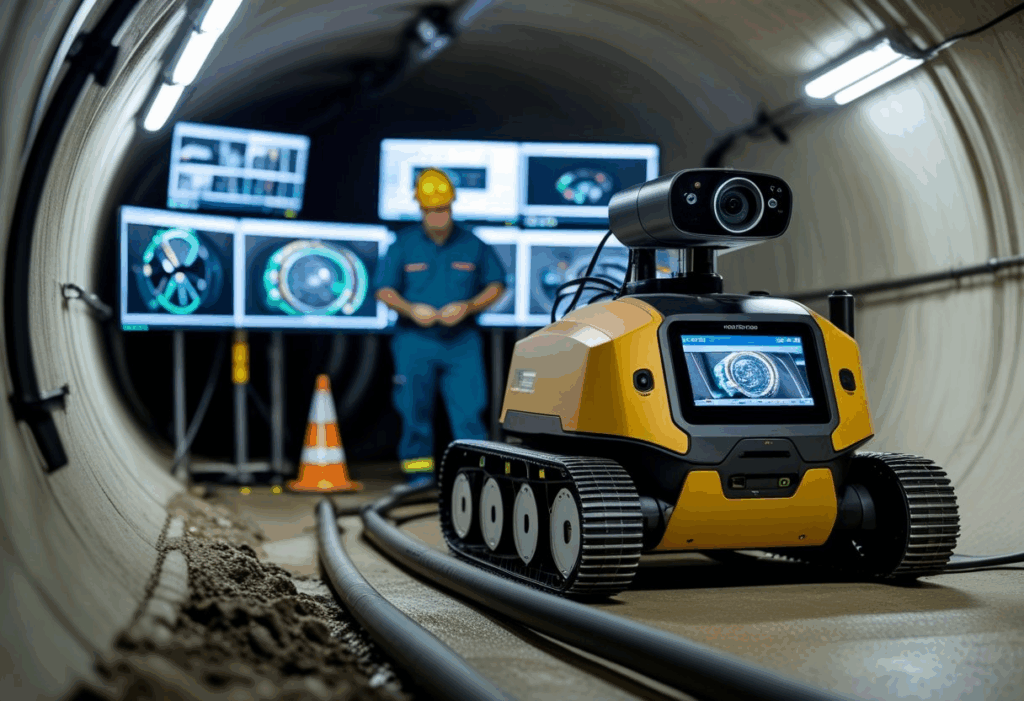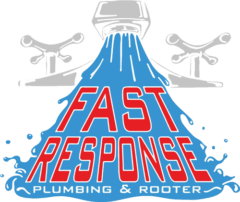Core Technologies Transforming Sewer Line Inspections
New technologies help us inspect sewer lines more safely and with greater accuracy. These advancements lead to quicker fixes, less digging, and better information about what’s happening underground.
Robotic and CCTV Camera Systems
We use robotic crawlers equipped with CCTV cameras to look inside pipes without digging. The camera sends live video to a monitor, letting us see blockages, cracks, or root intrusion up close. Operators can control the robot’s movement and focus, making it easy to check every part of the pipe.
These tools work in different pipe sizes and are waterproof, so they perform well in wet or dirty environments. Some models have extra tools for taking samples or removing small obstacles. With these systems, we create detailed inspection reports and store footage for later review.
Key features:
- High-definition video
- Pan and tilt control
- Real-time problem detection
Drone-Assisted Sewer Inspection
Drones are now being used to inspect large or hard-to-reach sewer areas, especially those that are unsafe for people. We use drones for both above-ground mapping and to fly into large-diameter pipes or tunnels. With high-resolution cameras and sensors, drones collect data and images quickly.
In tight or dangerous spots, drones lower the risk to workers. Some even carry thermal or gas detection sensors, helping us spot leaks or gas build-up. Drones also cover more ground in less time, making inspections faster than with manual checks.
Advantages:
- Less risk for inspection workers
- Fast data collection
- Access to places humans can’t safely reach
Sonar and Laser Profiling Technologies
We sometimes need to know the exact shape and size of a pipe, especially when dealing with old systems. Sonar profiling uses sound waves to map pipes filled with water or debris. Laser profiling scans pipe walls to find cracks, deformities, or corrosion with high precision.
These tools don’t rely on light, so they work well even in dirty water. They give us detailed 3D models and measurements that are essential for planning repairs. By comparing scans over time, we can track pipe wear and predict future problems.
Main uses:
- Finding leaks below water line
- Measuring pipe ovality and wear
- Planning repairs based on exact pipe condition
Role of Artificial Intelligence and Data Analytics

Artificial intelligence helps us find sewer line problems faster and more accurately. With data analytics, we can make smarter decisions and manage sewer systems more efficiently than ever before.
AI-Powered Defect Detection
AI helps us spot cracks, blockages, and other pipe issues in inspection videos and images. Instead of checking each video frame by frame, we use machine learning models to identify defects automatically. This saves time and reduces human error.
We train AI systems on thousands of examples, so they learn what common defects look like. For instance, our software can highlight corrosion, root infiltration, and structural failures with a high degree of accuracy. When used together with high-definition cameras and sensors, these tools help us catch minor defects before they become major problems.
This early detection supports our proactive maintenance approach. We can schedule repairs and prevent more costly and disruptive failures.
Automated Condition Assessments and Reporting
With automated condition assessments, we can quickly understand the health of sewer lines. AI tools review inspection data, assign grades to pipe segments, and flag the most urgent issues. The system then creates standardized reports for our teams to review.
Reports often include:
- Pipe condition scores
- Location of defects
- Severity of each issue
- Suggested maintenance or repairs
Automation helps us keep consistent and objective records. It also shortens the time needed to inform city staff, contractors, and other decision-makers. This efficiency means we can plan maintenance or upgrades before small issues turn into service interruptions.
Integration with Asset Management Platforms
We connect AI findings and inspection data to our asset management platforms. This integration lets us track each sewer pipe’s history, its repair status, and its current condition all in one place.
With this data, we can:
- Plan inspection and maintenance schedules
- Prioritize high-risk pipes for upgrades
- Monitor the effectiveness of past repairs
Our asset management tools use data analytics to spot trends and predict future problems. This helps stretch budget dollars and keeps the sewer system running smoothly for everyone in the community. By linking AI with other digital tools, we get a complete, up-to-date view of our entire infrastructure.
Impact of Technology on Urban Infrastructure and Maintenance Strategies

New inspection technology is helping us keep sewer systems in better shape. We can now find and fix problems early, use budgets more wisely, and plan repairs that cause less disruption.
Proactive Maintenance Approaches
We use advanced tools like robotic cameras and sensors to inspect sewer lines with little digging. These tools let us see cracks, blockages, or breaks in real time.
Because we catch small issues early, we can schedule repairs before they become expensive emergencies. This approach helps us reduce the risk of sewage backups and environmental damage.
A proactive maintenance plan includes:
- Scheduling regular digital inspections
- Using software to spot patterns or common trouble spots
- Fixing minor damage before it spreads
By working this way, we keep urban infrastructure in better condition and spend less money on emergency repairs.
Rehabilitation Planning and Resource Allocation
Technology gives us more data about sewer conditions, making it easier to decide which pipes need repairs first. We use mapping tools and digital records to track the age and health of every line.
This information helps us create a rehabilitation plan that fits our needs and budget. We can prioritize areas with the highest risks or the most impact on the community.
Resource allocation is more efficient since we know where to focus crews, equipment, and materials. We avoid wasting time or money on unnecessary projects, and we keep disruptions to traffic and neighborhoods at a minimum. Digital planning also helps us adjust quickly if conditions change.
Health, Safety, and Environmental Benefits
New tools and digital methods are changing how we check sewer lines. These advances are making jobs less risky for workers and are helping us better protect local water and soil.
Worker Safety Improvements
Using cameras, drones, and robots, we can now inspect sewer lines without sending crews underground as often. This remote inspection reduces the chance of injuries from harmful gases, falls, or confined spaces.
Our teams now use portable gas detectors and real-time video feeds to spot dangers before anyone enters a pipe. Simple tablets or smartphones display the exact location of breaks or clogs, so only specific repairs are needed.
We also keep better records of each inspection. With digital logs, we track safety risks and make sure everyone follows our safety standards. These steps lower the chance of accidents and help us follow strict safety rules.
Environmental Monitoring and EPA Compliance
Technology allows us to find leaks, illegal discharges, and blockages quickly, which prevents sewage from polluting the environment. Sensors and smart mapping give us instant data on water flow and pipe conditions.
We use this data to address problems before spills happen. Digital tools also help us document each inspection, making it easier to meet EPA and local environmental rules.
Automated reporting systems create clear records for audits and reviews. This keeps us ready for EPA inspections and helps avoid violations that could harm public health. By monitoring our systems closely, we can respond faster to any environmental risks.
